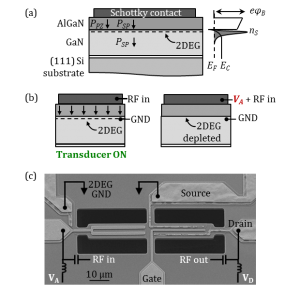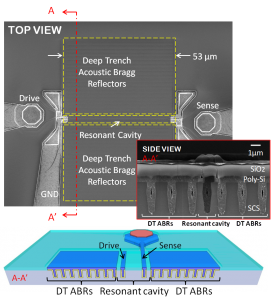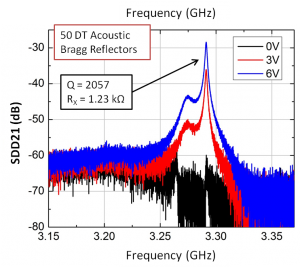Switchable Piezoelectric Transduction in AlGaN/GaN MEMS Resonators
High-Q MEMS resonators, with small footprint and monolithic integration, are excellent building blocks for configurable RF systems. While these resonators provide narrow bandwidth selectivity, broad-band operation typically requires a large bank of switchable devices. This bank introduces a large capacitive load at the input due to the drive transducers. Typically, piezoelectric resonators have strong electromechanical coupling coefficients enabling low loss filters. However, they must be switched in line of the RF signal, resulting in insertion loss and reduced power handling.
This work presents a new implementation of piezoelectric transduction in an AlGaN/GaN heterostructure that enables on/off switching of transduction with DC voltage applied out-of-line of the RF signal and reduces the capacitive load of the resonator by >10× when in the off state. This transducer is formed in the AlGaN, between a top Schottky electrode and a 2D electron gas (2DEG) as a second electrode[1],[2] (Figure 1). When a negative bias of -7 volts is applied to the Schottky electrode, the 2DEG is depleted. The removal of this bottom electrode suppresses electromechanical transduction and serves to reduce the drive capacitance by >10×.
Mechanical resonances can be detected with a passive transducer equivalent to the drive, or with a high electron mobility transistor (HEMT) embedded in the resonator, which has been previously shown to enable sensing at higher frequencies[3],[4]. The HEMT-sensed device is illustrated in Figure 1c. The DC behavior of the embedded HEMT is shown in Figure 2a, while the measured frequency response of the resonator is illustrated in Figure 2b. Applying a negative bias to the drive transducer depletes the 2DEG and suppresses the resonance signal while reducing the drive capacitance by 13×. The resonance at 2.67 GHz has Q of 650 in air with f·Q of 1.7×1012, the highest in GaN resonators to date.
- Figure 1: (a) 2DEG confined in conduction band potential well at the interface between AlGaN and GaN. (b) Principle of switchable piezoelectric transduction. (c) SEM of piezoelectric-drive, HEMT-sensed resonator.
- Figure 2: (a) Measured IV curves of the HEMT embedded in resonator (b) Measured frequency response of resonator, in air. The transconductance, g_m = Y_21-Y_12 , is suppressed when the 2DEG under the drive electrode is depleted.
- K. Brueckner, et al., “Two-dimensional electron gas based actuation of piezoelectric AlGaN/GaN microelectromechanical resonators,” Applied Physics Letters, vol. 93, pp. 173504:1-3, 2008. [↩]
- K. Tonisch, et al., “Piezoelectric actuation of (GaN)/AlGaN/GaN heterostructures,” Journal of Applied Physics, vol. 104, pp. 084516:1-8, 2008. [↩]
- D. Weinstein and S. Bhave, “The Resonant Body Transistor” Nano Letters, vol. 10(4), pp. 1234-37, 2010. [↩]
- M. Faucher, et al., “Amplified piezoelectric transduction of nanoscale motion in gallium nitride electromechanical resonators,” Applied Physics Letters, vol. 94, pp. 233506:1-3, 2009. [↩]



